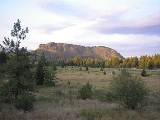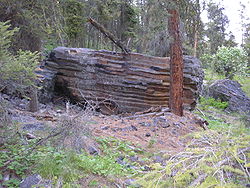
Mount Boucherie
Encyclopedia
Mount Boucherie is a mountain
located in West Kelowna on the west shore of Okanagan Lake
, British Columbia
, Canada
, opposite the city of Kelowna
. It is the remnants of a former stratovolcano
created nearly 60 million years ago. Between four and six different glacial periods over the past 50 million years have eroded the volcano to produce Mount Boucherie. Though it now only rises 417 meters above the nearby lake level, it is estimated to once have had an elevation of 2000 m (6,562 ft) or more.
Other names for the mountain are also documented in various historical documents:
 Mount Boucherie is composed primarily of rhyolite
Mount Boucherie is composed primarily of rhyolite
and andesite
, which gives the mountain its yellow, tan and pinkish colours on the north and south flanks. The more prominent black and dark gray east and north-east face is dacite
. Near the base of the east face is an area with many The columns, or pipes, were formed in the later stages of Mount Boucherie's volcanic period, as evidenced by the fact that the dacite columns intersect older rhyolite
and andesite
volcanic rock
. Above the valley floor, the east cliff face is composed of folded volcanic flows of dacite.
Mount Boucherie is part of the Chilcotin Group which is an area thought to have formed as a result of back-arc extension
behind the Cascadia subduction zone
.
The early Cenozoic
was a tectonically active time in southern British Columbia, and the landscape of the time probably reflected the volcanism and faulting that was occurring.
Mountain
Image:Himalaya_annotated.jpg|thumb|right|The Himalayan mountain range with Mount Everestrect 58 14 160 49 Chomo Lonzorect 200 28 335 52 Makalurect 378 24 566 45 Mount Everestrect 188 581 920 656 Tibetan Plateaurect 250 406 340 427 Rong River...
located in West Kelowna on the west shore of Okanagan Lake
Okanagan Lake
Okanagan Lake is a large, deep lake in the Okanagan Valley of British Columbia. The lake is 135 km long, between 4 and 5 km wide, and has a surface area of 351 km². The lake's maximum depth is 232 meters near Grant Island...
, British Columbia
British Columbia
British Columbia is the westernmost of Canada's provinces and is known for its natural beauty, as reflected in its Latin motto, Splendor sine occasu . Its name was chosen by Queen Victoria in 1858...
, Canada
Canada
Canada is a North American country consisting of ten provinces and three territories. Located in the northern part of the continent, it extends from the Atlantic Ocean in the east to the Pacific Ocean in the west, and northward into the Arctic Ocean...
, opposite the city of Kelowna
Kelowna
Kelowna is a city on Okanagan Lake in the Okanagan Valley, in the southern interior of British Columbia, Canada. Its name derives from a Okanagan language term for "grizzly bear"...
. It is the remnants of a former stratovolcano
Stratovolcano
A stratovolcano, also known as a composite volcano, is a tall, conical volcano built up by many layers of hardened lava, tephra, pumice, and volcanic ash. Unlike shield volcanoes, stratovolcanoes are characterized by a steep profile and periodic, explosive eruptions...
created nearly 60 million years ago. Between four and six different glacial periods over the past 50 million years have eroded the volcano to produce Mount Boucherie. Though it now only rises 417 meters above the nearby lake level, it is estimated to once have had an elevation of 2000 m (6,562 ft) or more.
Origin of the name
Mount Boucherie is named after Isadore Boucherie, a farmer, stock-raiser, and an early settler to both Rutland and the west side of the lake. In the late 1880s, Isadore purchased the land which is still known today as Boucherie Ranch, and the mountain behind the ranch still carries his name.Other names for the mountain are also documented in various historical documents:
- Mount Edgar, named after Edgar DewdneyEdgar DewdneyEdgar Dewdney, PC was a Canadian politician born in Devonshire, England. He served as Lieutenant Governor of the North-West Territories and the fifth Lieutenant Governor of British Columbia.-Early life and career:...
, a former Lieutenant-Governor of British Columbia. It is uncertain how common this name may have been, or when it ceased to be used. - Mount Bouchier, or Bouchier Mountain, named after Isadore Bouchier
- Mount Boucherie, named after E. Boucherie, not Isadore Boucherie.
Geology

Rhyolite
This page is about a volcanic rock. For the ghost town see Rhyolite, Nevada, and for the satellite system, see Rhyolite/Aquacade.Rhyolite is an igneous, volcanic rock, of felsic composition . It may have any texture from glassy to aphanitic to porphyritic...
and andesite
Andesite
Andesite is an extrusive igneous, volcanic rock, of intermediate composition, with aphanitic to porphyritic texture. In a general sense, it is the intermediate type between basalt and dacite. The mineral assemblage is typically dominated by plagioclase plus pyroxene and/or hornblende. Magnetite,...
, which gives the mountain its yellow, tan and pinkish colours on the north and south flanks. The more prominent black and dark gray east and north-east face is dacite
Dacite
Dacite is an igneous, volcanic rock. It has an aphanitic to porphyritic texture and is intermediate in composition between andesite and rhyolite. The relative proportions of feldspars and quartz in dacite, and in many other volcanic rocks, are illustrated in the QAPF diagram...
. Near the base of the east face is an area with many The columns, or pipes, were formed in the later stages of Mount Boucherie's volcanic period, as evidenced by the fact that the dacite columns intersect older rhyolite
Rhyolite
This page is about a volcanic rock. For the ghost town see Rhyolite, Nevada, and for the satellite system, see Rhyolite/Aquacade.Rhyolite is an igneous, volcanic rock, of felsic composition . It may have any texture from glassy to aphanitic to porphyritic...
and andesite
Andesite
Andesite is an extrusive igneous, volcanic rock, of intermediate composition, with aphanitic to porphyritic texture. In a general sense, it is the intermediate type between basalt and dacite. The mineral assemblage is typically dominated by plagioclase plus pyroxene and/or hornblende. Magnetite,...
volcanic rock
Volcanic rock
Volcanic rock is a rock formed from magma erupted from a volcano. In other words, it is an igneous rock of volcanic origin...
. Above the valley floor, the east cliff face is composed of folded volcanic flows of dacite.
Mount Boucherie is part of the Chilcotin Group which is an area thought to have formed as a result of back-arc extension
Back-arc basin
Back-arc basins are geologic features, submarine basins associated with island arcs and subduction zones.They are found at some convergent plate boundaries, presently concentrated in the Western Pacific ocean. Most of them result from tensional forces caused by oceanic trench rollback and the...
behind the Cascadia subduction zone
Cascadia subduction zone
The Cascadia subduction zone is a subduction zone, a type of convergent plate boundary that stretches from northern Vancouver Island to northern California. It is a very long sloping fault that separates the Juan de Fuca and North America plates.New ocean floor is being created offshore of...
.
The early Cenozoic
Cenozoic
The Cenozoic era is the current and most recent of the three Phanerozoic geological eras and covers the period from 65.5 mya to the present. The era began in the wake of the Cretaceous–Tertiary extinction event at the end of the Cretaceous that saw the demise of the last non-avian dinosaurs and...
was a tectonically active time in southern British Columbia, and the landscape of the time probably reflected the volcanism and faulting that was occurring.
Mount Boucherie Regional Park
Mount Boucherie Regional Park covers 36.4 hectares (90 acres), but is generally accessible only through Eain Lamont Community Park.Eain Lamont Community Park
Eain Lamont Community Park is 2.54 hectares (6.28 acres) in size, located on Lakeview Cove Place at 49°51′10"N 119°34′04"W. This park serves as the starting location for the various summit trails and perimeter trails around the base of Mount Boucherie.Forest fire of 1992
In the early evening of May 7, 1992, a forest fire was accidentally started by two 11-year-old boys playing with matches behind Mount Boucherie Secondary School. This led to the evacuation of about 100 people while the blaze consumed 60 hectares of forest on the steep north and east slopes of Mount Boucherie. No houses were destroyed, and the fire eventually cost $170,000 to extinguish.See also
- List of volcanoes in Canada
- Volcanism of Canada
- Volcanism of Western CanadaVolcanism of Western CanadaVolcanism of Western Canada produces lava flows, lava plateaus, lava domes, cinder cones, stratovolcanoes, shield volcanoes, submarine volcanoes, calderas, diatremes and maars, along with examples of more less common volcanic forms such as tuyas and subglacial mounds.-Volcanic belts:*Anahim...

